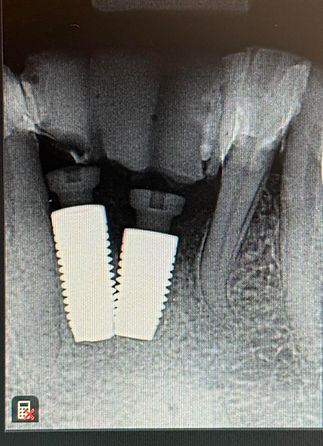
Causes
-
Dental implants are life-changing but not risk-free. Knowing what causes failure can help you avoid pain, infection, and expensive retreatment.
-
Most dental implants succeed long term, but failure still occurs in up to 20- to 40% of cases.
-
Dental implant failures can be categorized by timing (early vs. late failure) and by cause (biological, mechanical, or iatrogenic). Here's a structured overview:
Early Implant Failure (before osseointegration)
Occurs within the first weeks to months after placement, often due to:
-
Poor Bone Quality or Quantity
-
Inadequate bone volume for stability
-
Low bone density (e.g., in the posterior maxilla)
-
-
Surgical Trauma
-
Overheating the bone during drilling
-
Excessive compression of cortical bone
-
-
Contamination or Infection
-
Bacterial contamination at the time of placement
-
Poor aseptic technique
-
-
Micromovement of the Implant
-
Lack of primary stability
-
Premature loading or patient non-compliance
-
-
Systemic Health Issues
-
Uncontrolled diabetes
-
Smoking
-
Immunosuppression or chemotherapy
-
-
Medication-Related Complications
-
Bisphosphonates
-
SSRIs or PPIs (possible effects on bone healing)
-
Late Implant Failure (after osseointegration)
Occurs months to years later, often due to:
-
Peri-Implant Mucositis
-
Inflammation of soft tissues around the implant
-
Usually reversible with good oral hygiene
-
-
Peri-Implantitis
-
Progressive bone loss with inflammation
-
Caused by plaque accumulation and pathogenic biofilm
-
May be accelerated by poor prosthetic design or cement remnants
-
-
Excessive Occlusal Forces / Bruxism
-
Overloading of the implant
-
Lack of occlusal adjustment or protective appliances
-
-
Poor Prosthetic Planning or Execution
-
Misaligned implants
-
Ill-fitting abutments or restorations
-
Cement left in peri-implant sulcus (if not screw-retained)
-
-
Inadequate Maintenance
-
Lack of patient compliance with hygiene and recalls
-
No regular professional cleaning or monitoring
-
-
Mechanical Failures
-
Fractured implant, screw, or abutment
-
Loosening of components
-
Iatrogenic Causes
These are failures resulting from the clinician’s technique or decision-making:
-
Improper case selection
-
Poor surgical technique
-
Inadequate preoperative assessment (e.g., CBCT not used)
-
Poor communication between the surgeon, the restorative dentist, and the lab6
Key Risk Factors
-
History of periodontitis
-
Smoking
-
Poor oral hygiene
-
Infrequent maintenance visits
-
Systemic disease (especially uncontrolled)